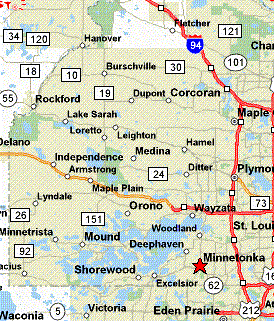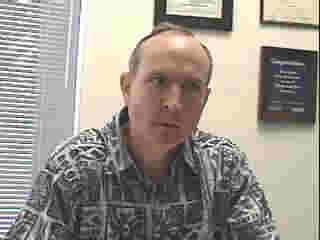Goal: Every voter may rank the candidates.
Often there are three or more candidates for a single office. Currently we are allowed to choose only one as our vote. We should also be allowed to say who our second choice would be, and our third, and so on.
As voters, ranking our choices would allow us to express our opinion about all the candidates. Choosing only one is frustrating, because we sometimes are forced to choose between voting for the candidate we really want or voting against the one we really donít want.
MINNESOTA GENERAL ELECTION BALLOT NOVEMBER 7, 2006 |
|||
SECRETARY OF STATE |
1ST CHOICE |
2ND CHOICE |
3RD CHOICE |
BRUCE (BK) KENNEDY |
O |
0 |
0 |
SHIRLEY TOOPARTISAN |
0 |
0 |
O |
PAT RESPONSES |
0 |
O |
0 |
Our elections will be better if we rank our choices, because we are more likely to elect candidates who are supported by the majority. Under our current process, called plurality voting, the candidate with the most votes wins, even if the candidate only has 35% of the vote. Under a ranked voting process called Instant Runoff, if no candidate has a majority of first choices, then you recount the votes again after eliminating the bottom candidate. If your first choice was the bottom candidate, your vote would transfer to your second choice. Eventually, a candidate will get more than 50% of the remaining votes, thus establishing who is the publicís favorite when the field is narrowed down to the strongest candidates.
For a Flash demonstration, click here
I take it as a matter of faith that the system is best when the winners are supported by the majority. We need to adhere to a majority winner principle for executive offices. If we donít, we allow our politics to be dominated by well-organized groups who donít represent the majority view. We punish candidates and their supporters who offer a third or fourth perspective in a campaign.
The Secretary of State does not have the power to put this kind of voting in place. This would have to be enacted by a local unit of government or the legislature. But the Secretary of State can promote plans like this and participate in their implementation.
With ranked voting, it's a matter of "If you build it, they will come." Cities and states will be more willing to try ranked voting if the voting equipment can process ranked ballots. Right now, the voting equipment of Minnesota would need to upgraded or replaced to do an automated ranked ballot election. The Secretary of State has great influence over the voting equipment that is developed and available. The current Secretary of State has fought to prevent our equipment from having this capablility. She has chosen to impede progress for reasons that she will not share.
If you're interested in bringing ranked voting to Minneapolis city elections, go here.
Here are some links to more information about Ranked Voting.
YouTube cartoon that explains IRV--3 minutes
http://www.chrisgates.net/irv/ Another flash demo which uses as examples the 2000 Florida presidential election and the 2000 Washington senatorial election.
http://www.fairvotemn.org/resources/tools/ Local
center for ranked vote information
http://www.fairvote.org/?page=189 Lots
of great information from the nationwide clearinghouse.
Australian demo (Note: In Australia, they call the process Exclusion or Bottoms Up.)
List of cities and counties that have had ranked voting ballot measures since 1998
San Francisco flash demo--official city versionIn 2004, the City of Roseville requested authorization from the state to consider using ranked voting for a special election. The request was defeated by the House of Representatives. To learn more about this travesty, go here.
Savings to Taxpayers
Used in non-partisan elections (city, county, and school board), ranked voting could save taxpayers money by eliminating the need for a primary election.
You could eliminate a primary in partisan elections too, but that is much more controversial because of the many political implications.
The city and school board elections are often held in odd numbered years. School boards are now required by law to hold primaries if needed to reduce the field to no more than two candidates for any one position. That means if there are four positions open and nine candidates, a primary must be held to eliminate only one candidate of nine.
Cities are not required to hold primaries, but often do to reduce the field so that the winners have majority support.
Counties elect their commissioners in even years, so the primary that reduces the field is held at the same time as state elections–no extra cost. However, if a commissioner resigns or dies with two or more years left on the term, the county must hold a special election to replace that commissioner. Ramsey County had that problem in 2005. The primary to reduce the field to two was very poorly attended and not a good value for the taxpayer. A ranked vote special election would have accomplished the same goal just as democratically, but more efficiently.
This recently happening in St. Cloud. Last December, Larry Haws was elected to the State Legislature with three years left on his term as Stearns County Commissioner. Turnout for the special election primary to replace Haws on February 14 was less than 8%. There’s less incentive to vote when you will fill in only one circle and leave. The two top vote getters in Stearns County continued campaigning until the March 14 election, even though one of them got more than 50% in the primary and won easily in the general. Turnout on March 14 increased to just over 8%: 1290 voters, compared to 1243 in the primary. Turnout for the November legislative special election primary in Buffalo was only 7%. By combining the primary and final election using ranked vote, you save dollars, time, and effort and get a result just as good or better. Later I will post a discussion of the pros and cons of primaries and how ranked vote can sometimes have a more true result than having a separate primary and general election.
If you're interested in bringing ranked voting to Minneapolis city elections, go here.


